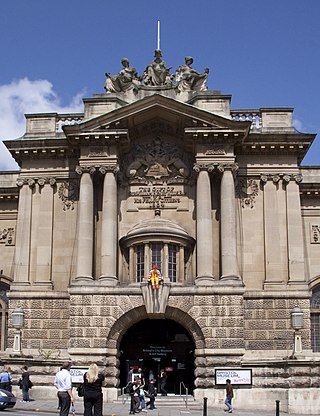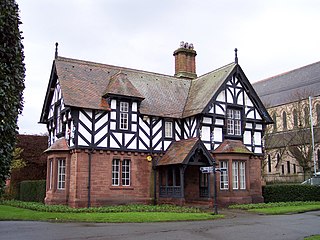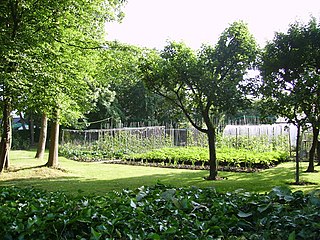
Chester is a cathedral city and the county town of Cheshire, England, on the River Dee, close to the England-Wales border. With a built-up area population of 92,760 in 2021, it is the most populous settlement of Cheshire West and Chester. It is also the historic county town of Cheshire and the second-largest settlement in Cheshire after Warrington.

Hugh Lupus Grosvenor, 1st Duke of Westminster,, styled Viscount Belgrave between 1831 and 1845, Earl Grosvenor between 1845 and 1869, and known as The Marquess of Westminster between 1869 and 1874, was an English landowner, politician and racehorse owner. He inherited the estate of Eaton Hall in Cheshire and land in Mayfair and Belgravia, London, and spent much of his fortune in developing these properties. Although he was an MP from the age of 22, and then a member of the House of Lords, his main interests were not in politics, but rather in his estates, in horse racing, and in country pursuits. He developed the stud at Eaton Hall and achieved success in racing his horses, who won the Derby on four occasions.

The University of Chester is a public university located in Chester, England. The university originated as the first purpose-built teacher training college in the UK. As a university, it now occupies five campus sites in and around Chester, one in Warrington, and a University Centre in Shrewsbury. It offers a range of foundation, undergraduate and postgraduate courses, as well as undertaking academic research.

Bristol Museum & Art Gallery is a large museum and art gallery in Bristol, England. The museum is situated in Clifton, about 0.5 miles (0.8 km) from the city centre. As part of Bristol Culture it is run by the Bristol City Council with no entrance fee. It holds designated museum status, granted by the national government to protect outstanding museums. The designated collections include: geology, Eastern art, and Bristol's history, including English delftware. In January 2012 it became one of sixteen Arts Council England Major Partner Museums.

The City of Chester was a constituency represented in the House of Commons of the UK Parliament since 2 December 2022 by Samantha Dixon of the Labour Party. She was elected in the by-election held following the resignation of Chris Matheson MP on 21 October 2022.

Louise Ingram Rayner was a British watercolour artist.

Chester city walls consist of a defensive structure built to protect the city of Chester in Cheshire, England. Their construction was started by the Romans when they established the fortress of Deva Victrix between 70 and 80 [CE]. It originated with a rampart of earth and turf surmounted by a wooden palisade. From about 100 CE they were reconstructed using sandstone, but were not completed until over 100 years later. Following the Roman occupation nothing is known about the condition of the walls until Æthelflæd refounded Chester as a burgh in 907. The defences were improved, although the precise nature of the improvement is not known. After the Norman conquest, the walls were extended to the west and the south to form a complete circuit of the medieval city. The circuit was probably complete by the middle of the 12th century.

The National Museum of Scotland in Edinburgh, Scotland, is a museum of Scottish history and culture.

Grosvenor Park is a public park in the city of Chester, Cheshire, England. It consists of 20 acres (8.1 ha) of land overlooking the River Dee. It is regarded as one of the finest and most complete examples of Victorian parks in the North West of England, if not nationally. On 22 August 2013 the designation of the park was raised from Grade II in the National Register of Historic Parks and Gardens to Grade II*.

The Dick Institute is a public library, museum and art gallery situated in Kilmarnock, East Ayrshire, in the west coast of Scotland. The building was originally opened in 1901 and has been recognised as a 4 star tourist attraction by VisitScotland.

Cliffe Castle Museum, Keighley, West Yorkshire, England, is a local heritage museum which opened in the grand, Victorian, neo-Gothic Cliffe Castle in 1959. Originating as Cliffe Hall in 1828, the museum is the successor to Keighley Museum which opened in Eastwood House, Keighley, in c. 1892. There is a series of galleries dedicated to various aspects of local heritage, and to displaying the house itself, which is a Grade II listed building.

The Falcon is a public house in Chester, Cheshire, England. It stands on the west side of Lower Bridge Street at its junction with Grosvenor Road. The Falcon is recorded in the National Heritage List for England as a designated Grade I listed building. The building formerly incorporated part of Chester Rows, but it was the first building to have its portion of the row enclosed in the 17th century.

Poulton is a settlement and former civil parish, now in the parish of Poulton and Pulford, in the Cheshire West and Chester, in the ceremonial county of Cheshire, England. In 2001 census the parish had a recorded population of 92.
The timeline of Cheshire history shows significant events in the history of the English county of Cheshire.

John Parsons Earwaker (1847–1895) was an English antiquary.
Peter Bressan was a noted woodwind instrument maker of whose work several examples exist in museums and private collections.

Storyhouse is a large, mixed-use cultural building in Chester, England, which opened in May 2017. The complex includes a theatre, cinema, restaurant and the city library. It is housed in the remodelled 1936 Odeon Cinema, a grade-II-listed building, together with a newly built extension to hold the theatre auditorium.

Elizabeth Jean Elphinstone Pirie was a British numismatist specialising in ninth-century Northumbrian coinage, and museum curator, latterly as Keeper of Archaeology at Leeds City Museum from 1960 to 1991. She wrote eight books and dozens of articles throughout her career. She was a fellow of the Royal Numismatic Society, president of the Yorkshire Numismatic Society and a fellow of the Society of Antiquaries of London.


















